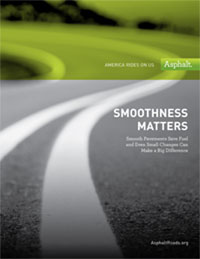 Smooth (adj.) smooth·er, smooth·est Having a surface free from irregularities, roughness, or projections; even.
Smooth (adj.) smooth·er, smooth·est Having a surface free from irregularities, roughness, or projections; even.
Not really a difficult concept is it? Smoothness matters is a reality every child discovers quickly as they learn to skate and/or ride a bicycle. But what exactly does smooth mean to the traveling public?
Experts say that vehicles consume less fuel when traveling on smoother pavements. This makes sense intuitively. And, lower consumption of fuel conserves natural resources for a healthier environment.
The United States has more 2.5 million miles of paved roads. Since Americans drive many miles per year, just a slight change in fuel economy per vehicle would result in dramatic fuel savings conserving our natural resources and benefiting the traveling public.
The Smoothness Principle
One compelling principle: Pavement smoothness is a significant determinant of vehicle fuel economy. The smoother the pavement, the lower a vehicle’s fuel consumption.
While auto makers continue to make progress on improving fuel efficiency of the engines in the vehicles they manufacture, researchers and state transportation agencies are looking at additional ways to reduce emissions. One area of study is the influence that pavement smoothness (or conversely, roughness) has on vehicle fuel consumption. The bottom line: the right pavements can reduce fuel consumption.
And the right pavements – the pavements that save fuel – are asphalt.
Asphalt is Smoother
If you are a coffee drinker you already know this, so does Congress’ General Accounting Office (GAO). In a 1999 General Accounting Office report to Congress, they noted, “Concrete roads may produce rougher readings than asphalt roads, even if the concrete road is of very high quality. Features such as joints between sections can contribute to the roughness of concrete highways.”
Accounting Office (GAO). In a 1999 General Accounting Office report to Congress, they noted, “Concrete roads may produce rougher readings than asphalt roads, even if the concrete road is of very high quality. Features such as joints between sections can contribute to the roughness of concrete highways.”
Nearly all states have smoothness standards for newly built roads. If the road does not meet the standard, the contractor’s pay is reduced. Some states have different standards for asphalt and concrete, and in every state where this is the case, the requirements for asphalt roads are more stringent than for concrete roads.
Building Smoother to Stay Smoother and Improve Fuel Efficiency
Keeping a road smooth begins with a well-engineered foundation and pavement structure. An asphalt Perpetual Pavement is designed and built to ensure that the structure lasts virtually indefinitely. Routine maintenance is simply a matter of periodically milling (about every 15 to 20 years) the surface for recycling, followed by placement of a smooth new overlay. Not surprisingly, these periodic improvements in ride quality significantly reduce fuel consumption of vehicles traveling these roads. Resurfacing an asphalt pavement gives the traveling public a road that’s just as good as new.

The Facts Are Clear
After closely examining the available research and investigating a variety of different factors, one thing is clear: of all pavement characteristics, smoothness is the major determinant of vehicle fuel economy. Simply stated, the smoother the pavement, the less fuel consumed by the vehicle.
For the brochure “Smoothness Matters,” click here.
For a published overview of smoothness and vehicle fuel economy, click here.
For a full discussion of some recent studies on this topic, click here.